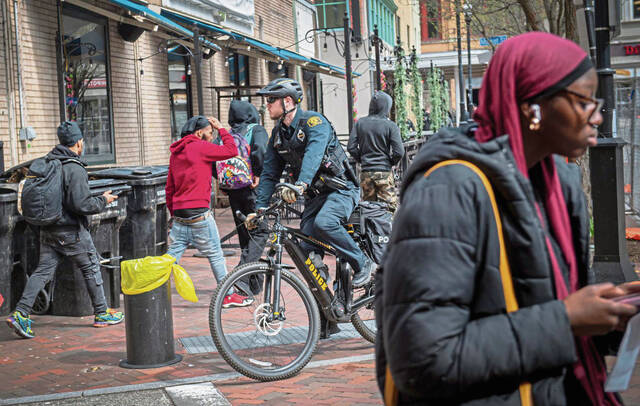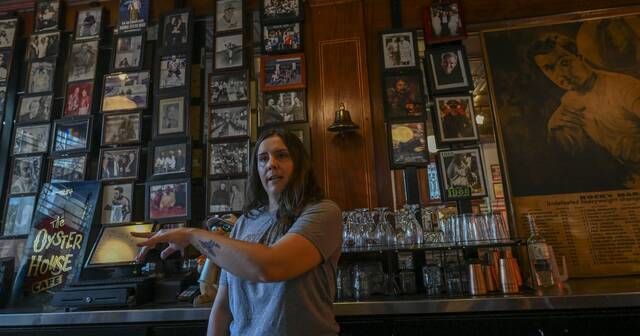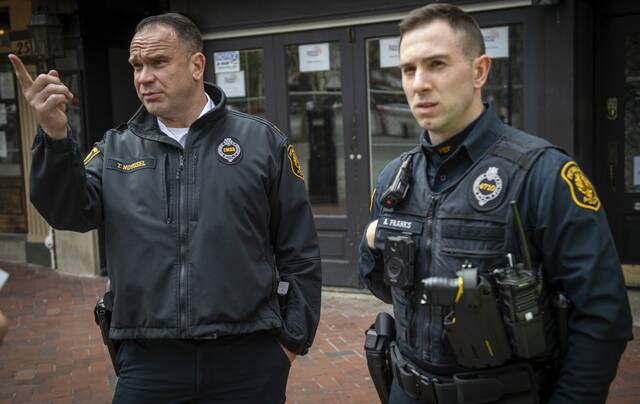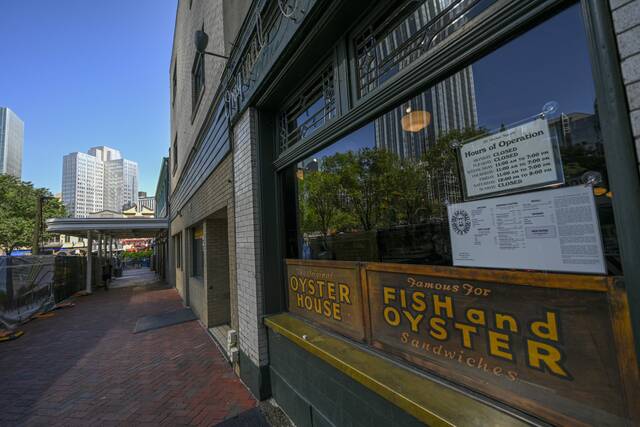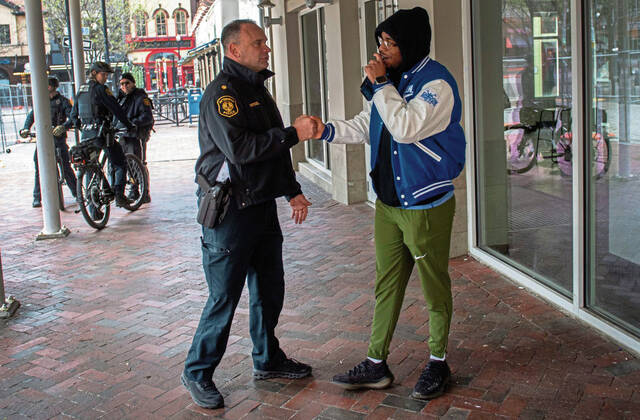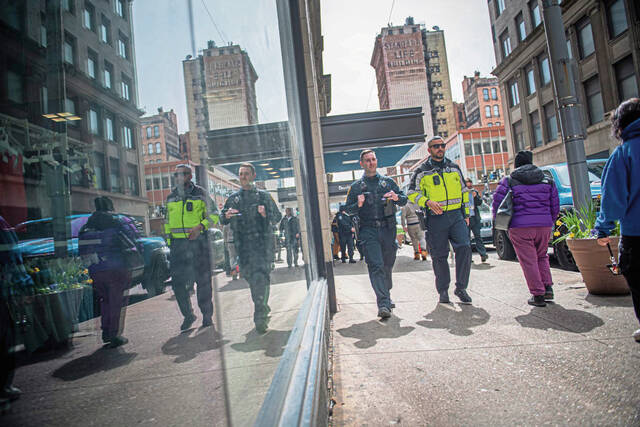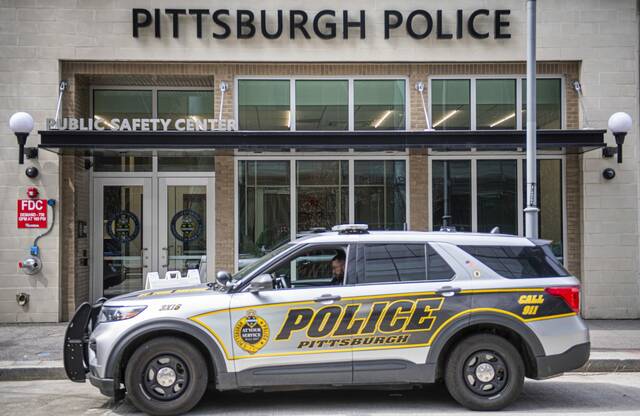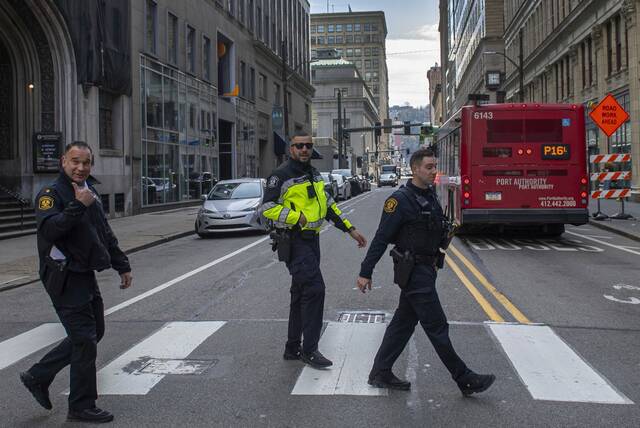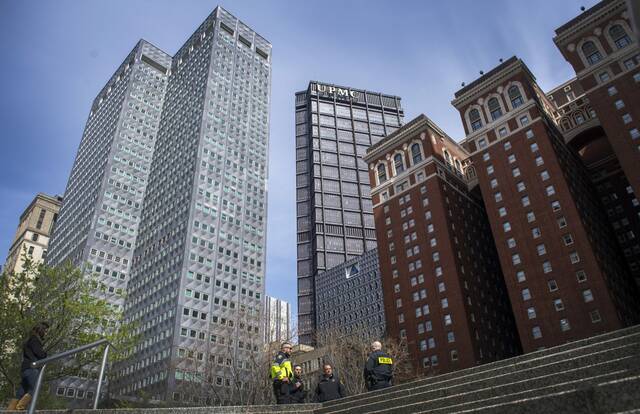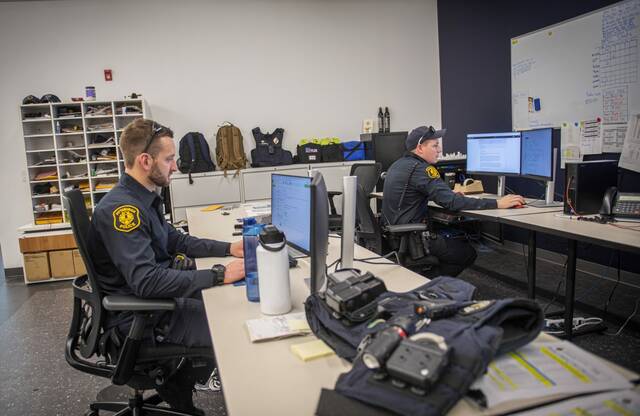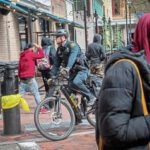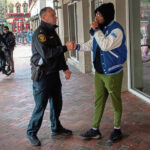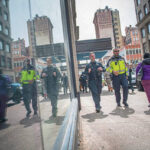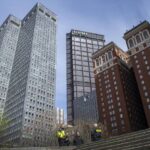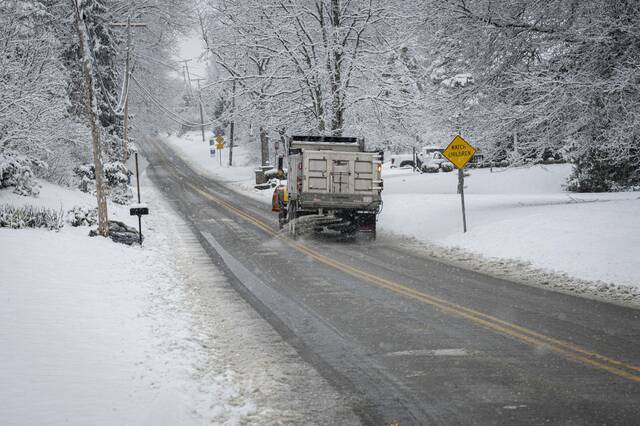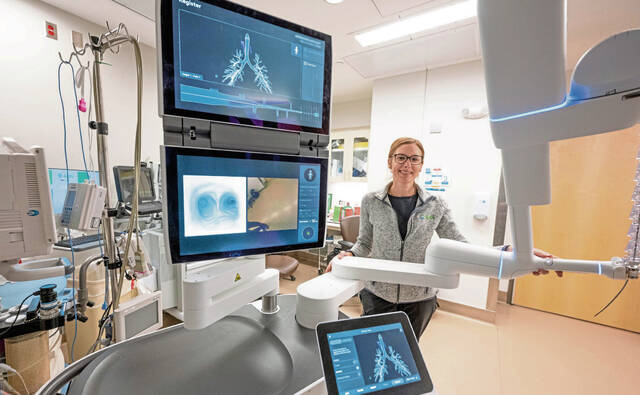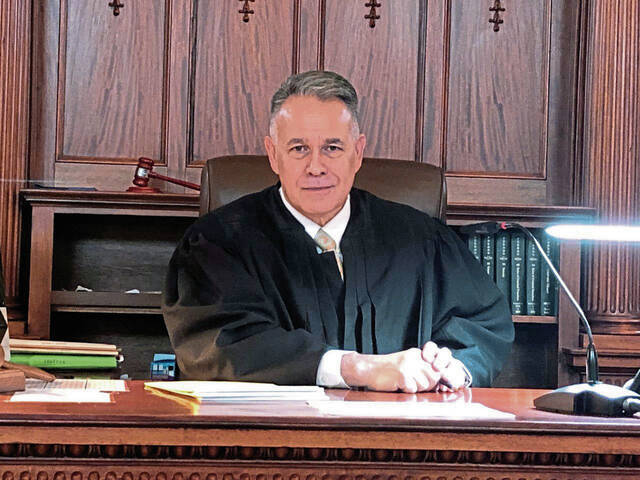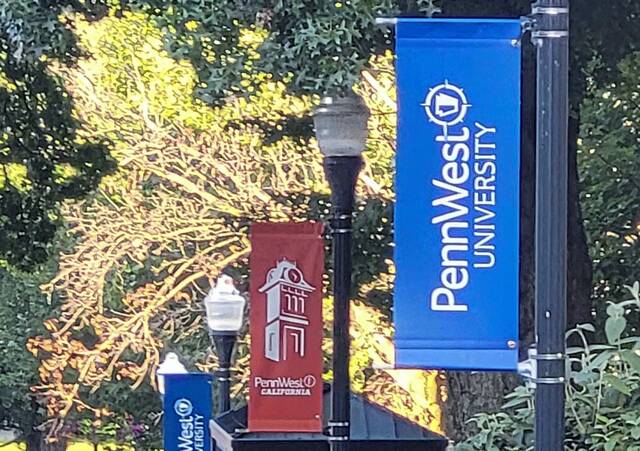Downtown Pittsburgh, by turns glamorous and grimy, boasts a split personality.
Pittsburgh Mayor Ed Gainey emphatically frames the gateway to the city as safe and vibrant. But persistent problems with homelessness, drugs and violent crime have long threatened to undermine that narrative.
Just last month, police charged a man with stabbing someone on Liberty Avenue, a main thoroughfare.
With next spring’s NFL Draft set to give Pittsburgh a marquee moment, and with the governor lauding $600 million in redevelopment projects across what is formally called the Central Business District, Downtown sits at a crossroads, caught between perception and reality.
The perception among critics: It’s dangerous.
The reality, according to boosters: Crime is largely down, crowds are returning, and the neighborhood faces the same problems as any other city.
Over the past several years, trouble Downtown has driven away business owners, turned off visitors who see its seedy underbelly and generated headlines for the occasional violent crime.
Clutches of homeless people congregate, belligerent characters sometimes intimidate pedestrians, and drug deals can go down in plain view. Sometimes there’s gunfire, a stabbing or a public beating.
But Downtown is also the Golden Triangle, home to beautiful concert halls, skyscrapers, the seat of government, courthouses, live theater and music, high-end restaurants and packed bars. There are venerable plazas, a winter market and open-air ice skating.
Those who call Pittsburgh home see the stark contrast. The 700,000 to 1 million people expected to visit in April for the NFL Draft might also witness the glitter — and the tarnish.
“We want to ensure Downtown is a welcoming place,” Jeremy Waldrup, president of the Pittsburgh Downtown Partnership, told TribLive recently. “We do have some significant challenges … but I feel there’s been a shift. I feel like things are going in the right direction.”
An empty bench
Pittsburgh police Lt. Robert Monticelli paced recently through Mellon Square, an acre of open space and greenery once riddled with drug dealers, and talked about change.
Monticelli recalled how in 2023 — as Downtown, stripped of many office workers, struggled to rebound from the pandemic — police constantly broke up drug deals in and around the parklet bordered by Smithfield Street and William Penn Place.
“You used to be able to come down, whistle and get what you wanted,” Monticelli said.
Now, a year after police launched a high-visibility patrol Downtown, drug arrests are down. Charges for some crimes, like thefts, are up. But officers say they’ve tamed drug hot spots like Mellon Square.
Obstacles remain. Officials say they’ve cleared 93% of Downtown’s homeless encampments. But a recent “point-in-time” survey showed the number of people living unsheltered in the area surged by 66% this year — to 281 people from 169 last year.
That’s despite Allegheny County earmarking about $50 million each year for tackling homelessness.
“We do feel like there’s still work to do,” Allegheny County Executive Sara Innamorato, who works out of the county courthouse on Grant Street, told TribLive. “We are dealing with the consequences of people falling through the cracks … and we have to mobilize to get those folks the help they need.”
Pittsburgh police Cmdr. Timothy Novosel says understanding Downtown safety requires good data.
Novosel, who leads the precinct that includes Downtown, does that with “heat maps.” They gauge criminal activity based on police observations and data culled from 911 calls — the darker the color, the denser the reports of crime.
“If you would have looked at these two years ago, that heat map would have been dark on Smithfield, it would have been dark in Mellon Square,” Novosel told TribLive. “Now there’s nothing.”
Novosel recently pointed to a single bench on the parklet’s Smithfield Street side. Homeless men set up camp there and would relieve themselves at the vacant storefronts.
These days, a wooden construction built over the retail spaces protects them while development awaits. Artwork celebrating notable Pittsburgh women, past and present, adorns the facade.
Monticelli says data shows public safety is improving Downtown. But the 20-year police bureau veteran said the gut feeling people have about Downtown is as important as the data.
“Not only do we have to change the statistics, we have to change the people’s perceptions,” Monticelli said. “And that’s what we’re trying to do.”
Stoking fear
Downtown Pittsburgh is safe. Downtown Pittsburgh is unsafe.
Both statements are true, depending on who you ask. Perception, experts say, is a powerful influence.
“There’s research showing links between ‘observed social disorder’ — maybe homelessness or vacant storefronts — and perceived crime,” said Ernesto Lopez, a California-based researcher for the Council on Criminal Justice. “Even if there is no relationship, there’s a perception that they very much overlap.”
Headline-grabbing incidents tend to fuel those fires, Lopez said. Downtown Pittsburgh has had its share:
• A brazen and bone-breaking attack in June 2024 on a 73-year-old man.
• A young woman from Pittsburgh’s suburbs who quit her internship after being savagely assaulted that same month on Smithfield Street.
• A teenager shot Downtown in February, just a block from a new police substation. The next day, Gainey held a news conference at the facility to somewhat incongruously tout his administration’s public safety record.
• Earlier this month, an Ohio man appeared in court on charges that he stabbed a 65-year-old man dozens of times on a Downtown sidewalk before dawn one day in June.
These crimes have a way of clinging to memory, Lopez said. There’s a partial explanation: media consumption.
Researchers in 1976 reported that “widespread television broadcasting” influenced “consumers’ attitudes and perceptions,” Lopez said. By 2003, research had shifted to the internet, noting peoples’ “attitudes and perceptions toward crime are also shaped by what they consume from media.”
Today, social media stokes fears of crime and victimization, Lopez said.
Research shows people who use social media most are the most likely to feel certain cities or neighborhoods suffer from heightened crime, according to an article published in 2017 in the journal Computers in Human Behavior.
“A lot of those things tend to sort of amplify these horrific events,” Lopez said.
Spike in thefts
Statistics tell differing stories.
Downtown drug arrests dropped nearly 30% from the first six months of 2024 to the same period this year, police data shows.
Business owners who herald Downtown’s return to pre-pandemic conditions point out there hasn’t been a homicide there since January 2023.
Some critics — like Denny Scott, who has run restaurants Downtown for 30 years — point to the volume of criminal activity. Arrests are up this year in each of Pittsburgh’s six zones, some of them dramatically. Zone 2, which includes Downtown, tops the list.
Reported robberies Downtown remained stable with last year. There were no sex assaults in the first half of this year or last year, police data show. Reported assaults grew slightly, up 4%, to about 250 incidents, in the same period.
But thefts have spiked more than 60% year over year, police data shows. For Makayla Reed, that’s a problem illustrated with ice cream.
The manager of Millie’s Homemade Ice Cream near Downtown’s Market Square said kids regularly steal ice cream out of her freezer and money out of her tip jar.
“Pretty much the only time that I’ve ever felt uncomfortable (Downtown) is when there’s a lot of kids around,” said Reed, 26. “They do roughhouse quite a bit.”
Reed has asked outreach groups to help. But that hasn’t stopped kids from going behind the counter or threatening to punch Millie’s employees when they’re asked to leave.
Reed has responded by snapping a bike lock around the freezer’s handles. Sometimes Millie’s will go into a “false close” until they deem the shop safe enough to reopen.
‘Never’ uncomfortable
Jennifer Grippo sees a different Downtown, one filtered through a decidedly Pittsburgh-esque sense of nostalgia.
Grippo’s family owns the Original Oyster House, a Market Square bar and restaurant dating to 1870. They bought the business in 1970, nearly two decades before she was born.
“This business means so much more than selling fish and buttermilk and Iron City beer,” Grippo, 35, recently told TribLive as she sat in the eatery after hours. “You can never buy that emotion. You can’t pay for that.”
While she grew up in Mt. Lebanon, Grippo spent a lot of time Downtown because of the family business. She remembers a different era: Grabbing coffee for her parents at Jenny Lee Bakery or playing the mechanical-claw game at G.C. Murphy.
Grippo nurses those memories. In the Oyster House, its floor lined with aging tile and its ceiling pressed in tin squares, the walls remain covered with black-and-white photos of Miss America contestants. A portrait of heavyweight boxer Rocky Marciano, whose heyday was in the 1940s and ’50s, still holds court on the bar.
She’s quick to note, though, that she doesn’t view everything through rose-colored glasses.
In May, someone burglarized her restaurant. Another time, a brick was thrown through a window. She calls both crimes isolated incidents.
“It happens. It really could happen to anyone — and it could always be worse,” Grippo said. “But I have never felt uncomfortable in any capacity Downtown.”
“Am I going to lock the (Oyster House) doors tomorrow and move away for the safety of my staff or of my customers?” she added. “Absolutely not.”
For every Oyster House that digs its heels into a corner of Downtown and stays put, there’s another business relocating.
The eatery Wiener World — which bills itself as “an old-school counter service joint” — moved off Smithfield Street last year. Scott, its owner, had grown tired of homelessness and robberies, people stealing food off his counters. Many days started with Scott spotting syringes and used crack pipes near his front door.
Wiener World reopened last summer in the food court of U.S. Steel Tower. Scott said business is up in what feels like a different neighborhood.
“It’s just two blocks away, but it might as well be a hundred miles,” said Scott, 57.
“When I walk to the bank, it’s still the same old cast of characters,” he added. “But it’s been a night-and-day difference here.”
Bouncing back
Beth Bershok has heard the same questions since leaving the South Hills to move Downtown nearly two decades ago.
“People will always ask, ‘You live Downtown? Do you feel safe?’ People have been asking me that for 16 years,” said Bershok, 62, chief marketing officer for the accounting firm Louis Plung & Co. “It’s like any other city. There are places in any city you need to be mindful of, where you don’t want to be hanging out at 2 a.m.”
Bershok recalled a recent exchange she observed in a Downtown store. One customer made a remark about the city’s homelessness problem. Another replied, “You must be kidding me. We’re from Seattle — you don’t have a problem here.”
“A lot of it is perspective,” Bershok said. “I could say, ‘Oh, I’m never going to Cranberry — it’s not safe!’ I mean, who am I to judge?”
Bershok has never been mugged Downtown. Or held at gunpoint. Nobody has broken into her apartment or cornered her while she walked to her company’s Stanwix Street office.
“I think we’re still bouncing back from the pandemic in a lot of ways. But I can tell you, as someone who’s here pretty much 24/7, it’s different than it was pre-pandemic,” said Bershok, while having lunch at Market Square’s Alta Via restaurant. Citing the drop in visible crime and uptick in development, she believes Downtown is even better than before the pandemic.
“When I have a problem getting a reservation at a restaurant on a random Tuesday,” she added, “things Downtown feel like they’re improving.”
Projecting confidence
For years, Pittsburgh’s mayor has struck an almost defiant tone when he talks about Downtown. Faced with naysayers, Gainey sometimes seems as if he’s trying to make Downtown safe simply by insisting it is.
Gainey stressed that those tapped into Downtown understand its obstacles — and are fighting for it.
The mayor acknowledged he’s “aware of the recent uptick in concern about public safety Downtown.”
“We take these concerns seriously — and we remain committed to both immediate response and long-term solutions,” Gainey said in a prepared statement in response to questions posed by TribLive.
“The energy around our restaurants, our theaters and our major festivals is a powerful testament to the progress we’ve made,” he said in the statement. “This city center is alive with activity. And that wouldn’t be possible if people didn’t feel confident about being here.”
Waldrup, the Downtown partnership leader, wants to fan those flames.
Seemingly disparate investments show that government officials, developers and corporate patrons harbor deep commitments to Downtown, Waldrup said.
In Market Square, which 3 million people visit annually, a $15.5 million renovation project now underway is poised to buoy business — and make the public space more event-friendly, Waldrup said.
Before the NFL Draft, state officials plan to spend $3.4 million to refresh Point State Park, upgrading fountain lighting, repairing walkways and improving landscaping at the 36-acre site at the confluence of the three rivers.
Millions more are helping convert offices into apartments in about 10 Downtown buildings, Waldrup said. Rugby Realty’s plans to build apartments and a tony hotel in Gulf Tower — the 44-story skyscraper that once reigned as Pittsburgh’s tallest building — grab public attention. All told, Downtown soon will see the creation of about 2,600 new housing units.
Waldrup feels enthusiasm breeds comfort. More than 60% of people responding to a recent Pittsburgh Downtown Partnership survey said they feel safe always or most of the time Downtown, a 7% jump from 2023, Waldrup said.
Under a microscope
Police patrolling Downtown told TribLive they also feel comfortable in a neighborhood making a comeback. It makes sense, police leaders say; cops must volunteer to work that beat.
Officer Jacob Hoch is among 22 Pittsburgh police who work Downtown — 17 officers, one detective, four supervisors. He’s worked for the department for six years, two of those years Downtown.
“There’s a lot more positive than negative when you’re down here,” Hoch, 33, of Brookline, said as he walked Smithfield Street this spring.
Novosel, the police commander, feels the officers themselves feed that positive narrative.
That’s because Zone 2 carries its weight, he said. The zone, which also includes the Hill District, Strip District and parts of Lawrenceville, had the highest call volume of any zone last year. Half of those calls went Downtown.
In 2024, Zone 2 accounted for more than one in every three arrests citywide, police data shows. Zone 3, which includes the South Side, reported half the arrests.
The cops, based in a modernized, brightly lit Wood Street building renovated in 2024, also lead the charge in proactive policing, police data shows. Up to 26% of officers’ time there last year focused on public safety work not tied to any crime.
That’s also important, Novosel said, because Downtown frequently is placed under the microscope.
“If a simple assault happens Downtown, it’s all over the news,” said Novosel, 52, of Brookline. “There are homicides in some neighborhoods that don’t get the attention a simple assault does Downtown.”
The next mayor
The two men vying to replace Gainey in January offer differing views on Downtown, though both agree it’s heading in the right direction.
Republican mayoral candidate Tony Moreno, a former Pittsburgh police officer, said police need to be more assertive.
“Gainey used to say, ‘We can’t arrest our way out of this.’ But that’s not true,” said Moreno, 56, of Brighton Heights.
Moreno wants to address “habitual offenders.” He said he also wants to reverse what he sees as “defund the police” trends that have decimated Pittsburgh’s rank and file.
Pittsburgh police have lost more than 200 officers in the past two years, a sizable chunk of a force that today numbers fewer than 800.
Depleted staffing also concerns Allegheny County Controller Corey O’Connor, the Democrat vying for Pittsburgh’s top elected post Nov. 4. He doesn’t cite concrete plans on how to stop the bleeding.
O’Connor instead maintains that Downtown needs big thinking.
“Right now, we’re lacking vibrancy, and I think that’s what everyone wants to see. What I see is an opportunity to define a new future for Downtown,” O’Connor told TribLive. “You want people to feel safe … and the small things go a long way toward building up the public’s confidence in Downtown.”
Innamorato, the county executive, is also bullish about the neighborhood where she works at least five days every week. She said she gauges the temperature on public safety Downtown based on what executives who work there say to her behind closed doors.
“Every person I’ve met with recently has said, ‘It’s better now,’ ” Innamorato said. “And that means we’re on the right path.”
Staff writer Megan Trotter contributed to this report.


